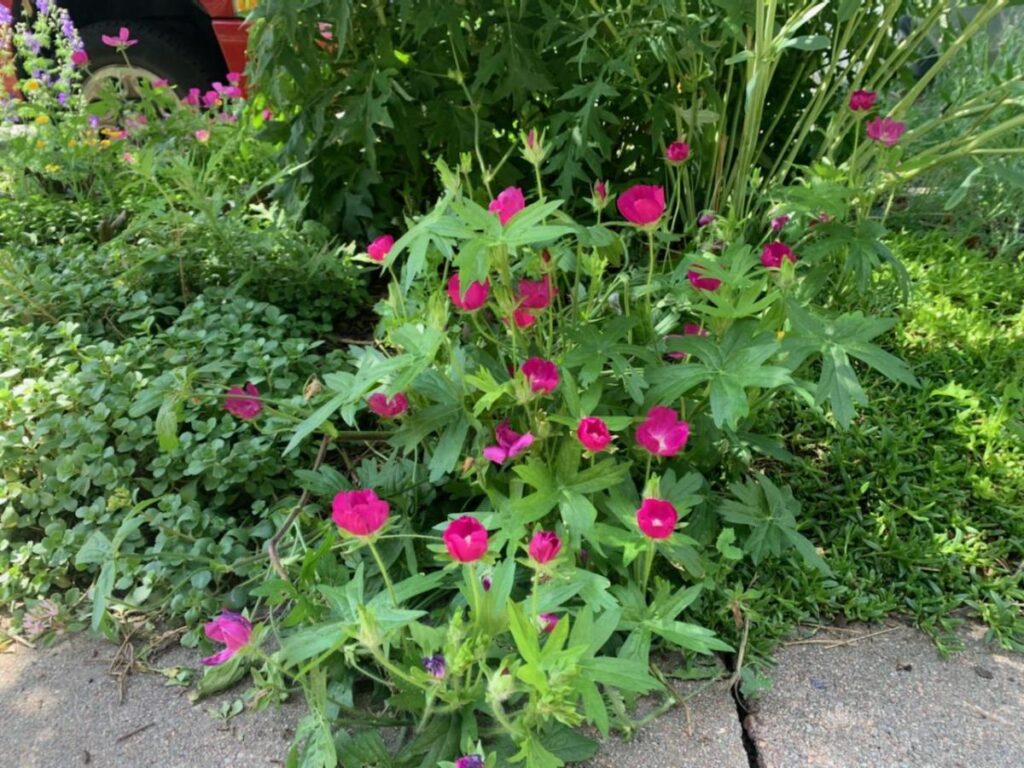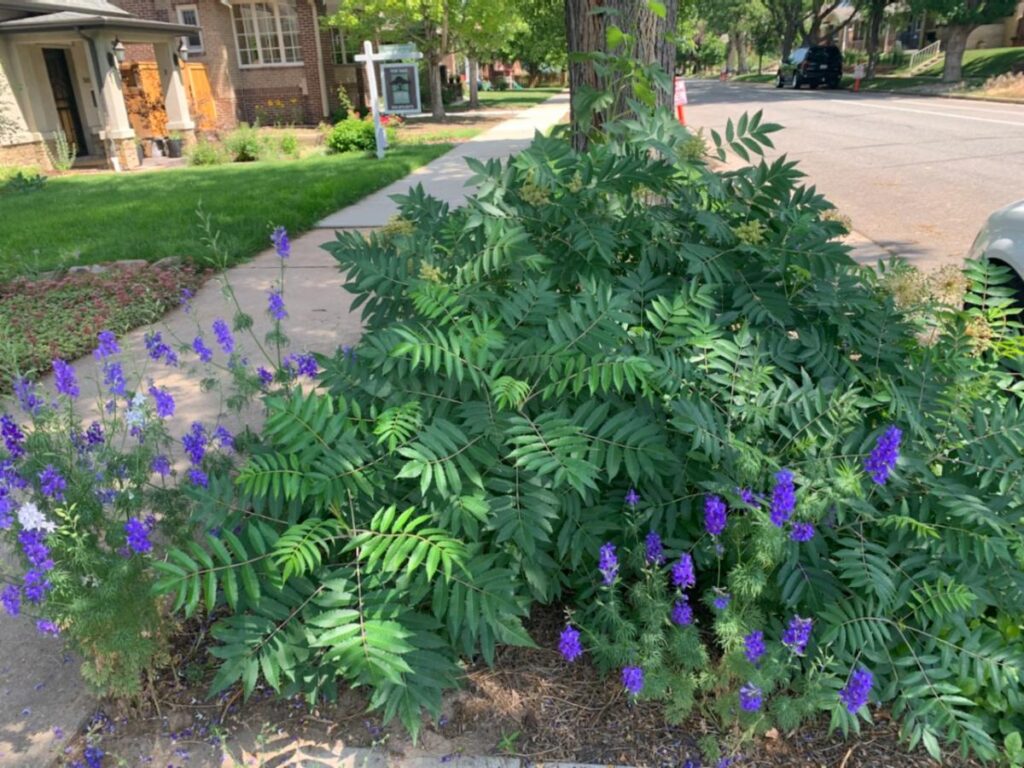By Deb Lebow Aal
I think most people believe that shade gardening with native plants requires quite a bit of creativity, especially on the Front Range of Colorado. We do not have many native trees, so there is not much shade. It’s a given that most plants require light and water to do their thing, and both are often lacking in shaded areas. But, it is possible. Embracing shade, rather than fearing it, can help.
We know the benefits of planting trees for the environment. The benefits are almost incalculable, and the subject of a different article. So, as we are planting more trees, preferably native and near-native tree species, we will have more shade to deal with in our gardens.
Partial shade and full shade are very different. Partial shade will allow more native species to do well. In fact, with our intense Colorado sun, many plant species with labels indicating they need full sun may do just fine in partial shade. Full shade will be more difficult. A really densely shaded area will probably support little, and what it does support will be mostly foliage. Four or more hours of sunshine a day will allow a much bigger palette of plants. So, assess the amount of shade under your tree before planting.
We do need to remember that a large portion of a tree’s biota is underground. We need to be cognizant of the density of the root structure, to know what can happily survive under a tree canopy. If plants are competing with a dense root structure, they obviously will have a more difficult time. And, you will have to water occasionally, as plants under a tree canopy get less rain water than those out in the open. Obviously, not much will survive with no water.
One or two more considerations. If your shade is facing north, the plants that will survive are different than if facing south. And, consider the edge, or transition zone from shade to sun, differently than the area completely under a tree. You will have to experiment with these plants, and, as with all plantings, there are no guarantees. Below are a few suggestions, first from my experience, and then from Jan Midgley’s.
Deb’s Suggestions
Aquilegia caerulea (Colorado Blue Columbine): Columbine seems to do better in mountain settings, but many people are successful with it on the Front Range. Because of how hot it is now in Denver, columbines appreciate some shade, and water.

Callirhoe involucrata (Prairie Winecups): These do very well in sun and are incredibly xeric, but if you plant them on the edge of a tree canopy, in dappled sunlight, they will do just fine. They may not have as many blooms as in full sun, but mine look happier and greener in partial shade.
Fragaria virginia (Wild Strawberry): While everything you read says strawberries need sun, I find that with our intense Colorado sun, my strawberry plants do best in partial shade, especially if planted on a south or west facing area. These produce tiny but very sweet strawberries, and are a nice ground cover in partial shade. If the shade is too deep, they will not fruit, but still a nice ground cover.
Juniperus communis (Common Juniper): I know, many people don’t like juniper, but it is an important plant for the ecosystem, hosting many caterpillar species. I happen to like them just fine. Generally, the ground cover varieties of juniper tolerate shade better. They will have a different growth – more of an open growth in shade, and will do better with some morning sun. Hiking in Colorado, I see many varieties of juniper growing well in partial shade. They prefer dry conditions, which is another good reason to try them in partial shade.
Kinnikinnick (Bearberry): A thick, evergreen ground cover. I find it very happy in shade, but it does not flower there. It probably will not do well on the Front Range in any amount of sun other than just a bit of morning sun.

Mahonia repens (Oregon Grape): this plant does well almost anywhere – sun, partial shade, deep shade – and with its three-season interest, is a favorite of mine, even though years ago it was overused in the nursery trade. The reason it was overused is a good one – it’s very easy to grow and not fussy at all.
Prunus virginiana (Chokecherry): This is a large bush or small understory tree, with white flowers in the spring followed by red berries. Chokecherry can grow in sun, partial shade or pretty dense shade.
Pulsatilla vulgaris (Pasque Flower): An early spring bloomer, this does well under deciduous trees that leaf out late, as it flowers in early spring. A good candidate for edge planting too.

Rhus glabra or Rhus trilobata (smooth or fragrant sumac): I love the habit of sumacs, and the fact that you can prune them to look like anything you want. One good point about all Rhus is that they bloom on new growth so you can prune them hard at the end of winter (not too late or you cut off new bloom buds).
Rosa woodsii (Woods Rose, our native rose, or Rosa blanda): These plants sucker, so you want to plant them somewhere where they have room to provide a thicket, which is wonderful for birds. They flower less in the shade than in sun, but are perfectly happy in dappled sun (like under a honey locust tree) or partial shade.
Jan’s suggestions
This list includes some grasses and forbs that will tolerate 4-6 hours of sun. They are all cool season grasses, meaning grasses that thrive in areas with cold winters and hot summers. However, these grasses grow most actively in spring and fall, when temperatures are more temperate.
Campanula rotundifolia (Bluebell bellflower): This very common wildflower will pretty much grow anywhere if it gets about 6 hours of sun. It’s little blue flower is lovely.
Delphinium ramosum (Mountain Larkspur): This gorgeous flower takes over in Deb’s yard, where it gets full sun. Much better in partial shade, where it is better behaved.
Elymus canadensis (Canada Wild Rye): This grass is a medium-size clumping grass with gracefully bending inflorescences.
Elymus elymoides (Squirreltail, also a wild rye): This grass grows to about 20 inches in height and can spread over time. The foliage will look a healthier green where it’s getting only 5-6 hours of sun, rather than full sun. Remember, these are cool season grasses.
Elymus glaucus (Blue Wildrye): This grass tolerates almost full shade. Everything you read about this lovely grass says it needs full sun, but it does quite well in shade.
Festuca saximontana (Rocky Mountain Fescue): This is a short clumping grass with narrow leaves that probably needs 4-6 hours of daily sun.
Holodiscus dumosus (Bush or Rock Spirea): In the rose family, this plant looks nothing like a rose, but has tiny white to pink flowers, and can grow to six feet wide. When you look this plant up, it actually says to plant in partial shade!
Mirabilis multiflora (Desert 4 o’clock): This lovely meandering plant will be happy with six hours of sun. Deb has it planted on the edge of dappled shade.
Oreocarya virgata (Miner’s Candle): Needs 6 hours of sun. Deb has only seen these on hikes, in the wild. But Jan is having luck in her garden with them.
Ribes aureum var. vilosum (Clove Current): Morning sun is enough for foliage. It may not flower much in the shade, but it will do fine. Same with Ribes cereum (Wax Currant).
Rudbeckia laciniata var. ampla (Cutleaf Coneflower): Four hours of sun is enough, although it needs more water than other prairie plants listed here.
Thelosperma filifoluium (Stiff Greenthread): Little yellow flowers on thread-like foliage (hence the name). Needs 6 hours of sun.
As with all our articles, this list of plants is partial. There are many more native plants that will do well in shade. The best way to find those plants is to hike around the foothills to see what grows where, and with what, and copy nature.
And, again, this list is from our experience. Remember that Wild Ones is a neighbor-to-neighbor helping organization, and we need to hear from more of you. We are not the scientists (although we have many in our midst). So, as always, let us know your experience of which native plants do well in shade. We will publish an addendum if we get enough responses. Please respond here. And, thanks!
